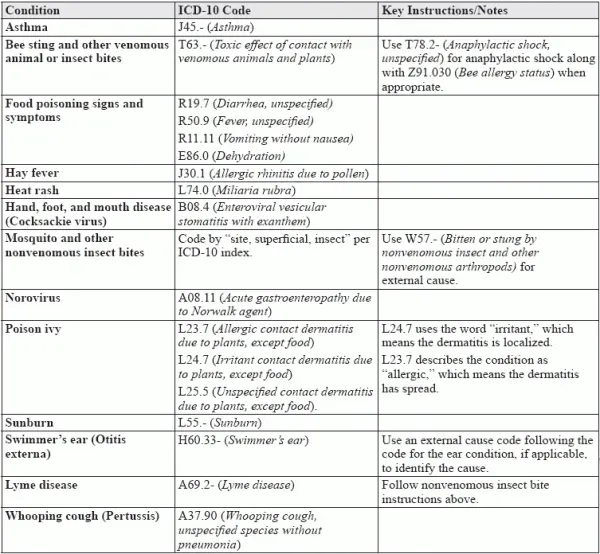Pediatric Coding Alert
Use This Chart to Code Common Summer Conditions
And make sure you have your E/M, procedure coding ready to roll. Summer is the time for cookouts, camping trips, and waiting rooms full of sick and injured patients. The days may be lazy and hazy for some, but for you, they can mean additional work and plenty of headaches. To ease your workflow, we’ve prepared this quick-reference guide full of codes to help you quickly and easily report many of the most common pediatric summer conditions. And we’ve added some expert advice that’s not to be sneezed at to help you use them, and various procedure codes, correctly. Expert Tip 1: Determine Details with Decisive Digits. “When coding for insect bites, you should keep in mind that there are over 350 diagnoses that could relate based on site and care,” says Chelle Johnson, CPMA, CPC, CPCO, CPPM, CEMC, AAPC Fellow, billing/credentialing/auditing/coding coordinator at County of Stanislaus Health Services Agency in Modesto, California. “The seventh digits, A [Initial encounter], D [Subsequent encounter], and S [Sequela], will also play a role in each case. The final digits in the case of swimmer’s ear, which require indication of left, right, or bilateral, will too, but here you will use sixth digits 1, 2, or 3,” Johnson continues. “And sunburns will need to be defined based on whether they are first, second, or third degree, which is also indicated by adding 1, 2, or 3, as a fourth digit,” Johnson adds. Expert Tip 2: Choose E/M Codes Carefully. “Most of these problems can be considered ‘self-limiting’ or ‘minor,’” says JoAnne M. Wolf, RHIT, CPC, CEMC, AAPC Fellow, coding manager at Children’s Health Network in Minneapolis, Minnesota. “This limits the level of the medical decision making [MDM] component your pediatrician will provide, which will, in turn, limit the evaluation and management [E/M] level you can choose,” Wolf adds. Expert Tip 3: Add These FBR Codes to Your List. “Foreign body removals [FBRs], especially FBRs of the skin, happen all year round. Maybe it’s just because fish hooks are common in the Land of 10,000 Lakes where I live, but they seem to happen more in the summer for some reason!” says Wolf. Because of this, it’s a good idea to add to add 10120 (Incision and removal of foreign body, subcutaneous tissues; simple) and 10121 (… complicated) to your summer procedure-coding knowledge base. 
Related Articles
Pediatric Coding Alert
- Condition Spotlight:
Add This Advice to Your Asthma Coding Armory
Use this guide to capture conditions correctly. You know that the J45.- (Asthma) codes are [...] - Guidelines:
Can You Solve These 4 Neonatal Transfer of Care Scenarios?
Get them wrong, and your bottom line could be in jeopardy. The days after a [...] - Clip & Save:
Use This Chart to Code Common Summer Conditions
And make sure you have your E/M, procedure coding ready to roll. Summer is the [...] - You Be the Coder:
Beware of Procedure Type, Global Period, in This Neonate Encounter
Question: Our pediatrician just performed services for a newborn. On the first day, she performed [...] - Reader Question:
Assess Modifier Use in This Multiple Test Claim
Question: I have a question regarding administering the Vanderbilt assessment. We typically give the test [...] - Reader Question:
Stick to Specificity in This Dx Dilemma
Question: One of our pediatricians documented a patient’s chief complaint as abdominal pain in the [...]




